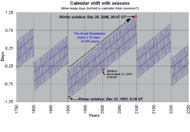December solstice
| UT date and time of equinoxes and solstices on Earth[1] | ||||||||
|---|---|---|---|---|---|---|---|---|
| event | equinox | solstice | equinox | solstice | ||||
| month | March | June | September | December | ||||
| year | ||||||||
| day | time | day | time | day | time | day | time | |
| 2010 | 20 | 17:32 | 21 | 11:28 | 23 | 03:09 | 21 | 23:38 |
| 2011 | 20 | 23:21 | 21 | 17:16 | 23 | 09:04 | 22 | 05:30 |
| 2012 | 20 | 05:14 | 20 | 23:09 | 22 | 14:49 | 21 | 11:12 |
| 2013 | 20 | 11:02 | 21 | 05:04 | 22 | 20:44 | 21 | 17:11 |
| 2014 | 20 | 16:57 | 21 | 10:51 | 23 | 02:29 | 21 | 23:03 |
| 2015 | 20 | 22:45 | 21 | 16:38 | 23 | 08:20 | 22 | 04:48 |
| 2016 | 20 | 04:30 | 20 | 22:34 | 22 | 14:21 | 21 | 10:44 |
| 2017 | 20 | 10:28 | 21 | 04:24 | 22 | 20:02 | 21 | 16:28 |
| 2018 | 20 | 16:15 | 21 | 10:07 | 23 | 01:54 | 21 | 22:23 |
| 2019 | 20 | 21:58 | 21 | 15:54 | 23 | 07:50 | 22 | 04:19 |
| 2020 | 20 | 03:50 | 20 | 21:44 | 22 | 13:31 | 21 | 10:02 |
The December solstice, also known as the southern solstice, is the solstice that occurs each December, typically between the 20th and the 22nd day of the month according to the Gregorian calendar. In the southern hemisphere, the December solstice is the summer solstice, whilst in the northern hemisphere it is the winter solstice.
Dates
Recent past and future dates and times, in Universal Time, of the December solstice are: [2]
- 2000-12-21 13:37
- 2001-12-21 19:21
- 2002-12-22 01:14
- 2003-12-22 07:04
- 2004-12-21 12:42
- 2005-12-21 18:35
- 2006-12-22 00:22
- 2007-12-22 06:08
- 2008-12-21 12:04
- 2009-12-21 17:47
- 2010-12-21 23:38
- 2011-12-22 05:30
- 2012-12-21 11:12
- 2013-12-21 17:11
- 2014-12-21 23:03
- 2015-12-22 04:48
- 2016-12-21 10:44
- 2017-12-21 16:28
- 2018-12-21 22:23
- 2019-12-22 04:19
- 2020-12-21 10:02
Solar year
The December solstice solar year is the solar year based on the December solstice. It is thus the length of time between adjacent December solstices.
The length of the December solstice year has been relatively stable between 6000 BC and 2000 at 49:30 (minutes:seconds) to 50:00 in excess of 365 days and 5 hours. After 2000 it is getting shorter. In 4000 the excess time will be 48:52 and in 10000 46:45.[3]
Human culture
Calendars

The figures in the charts show the differences between the Gregorian calendar and Persian Jalāli calendar in reference to the actual yearly time of the Southern solstice. The error shifts by slightly less than 1/4 day per year; in the Gregorian calendar it is corrected by a leap year every 4th year, omitting three such corrections in every 400 years, so that the average length of a calendar year is 365 97/400 days; while in the Persian calendar every eighth leap-cycle is extended to 5 years, making the average 365 8/33 days, shorter than the Gregorian average by one day every 13200 years.
The date of the solstice is not the same as the date of the latest sunrise and both are not the same as the date of earliest sunset. Because the Earth is moving along its solar orbital path, for each solar day the Earth has to do more than one full rotation. Because the Earth's orbit is elliptical, the speed at which the Earth moves along its orbit varies. Consequently, solar days are not the same length throughout the year. "Mean time" is the way of correcting this, making each day the same length, i.e. 24 hours. The maximum correction (see Equation of Time) is ± 15 minutes to the mean but its value changes quite rapidly around the solstices. If solar time were used rather than mean time, the latest sunrise and earliest sunset and therefore also the shortest day would all be at the solstice.
Commemorations
References
- ↑ United States Naval Observatory (2010-06-10). "Earth's Seasons: Equinoxes, Solstices, Perihelion, and Aphelion, 2000-2020".
- ↑ Earth's Seasons — Naval Oceanography Portal
- ↑ Bromberg, Irv. "Solar Year Length Variations on Earth". University of Toronto, Canada. Retrieved 21 December 2012.
